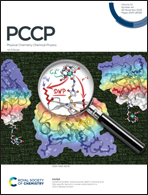Two-dimensional diamine-linked covalent organic frameworks for CO2/N2 capture and separation: theoretical modeling and simulations†
Abstract
Two-dimensional covalent organic frameworks (2D-COFs) with diamine-based linkers have been designed and investigated for CO2/N2 gaseous mixture adsorption and separation via a systematic theoretical study by combining density functional theory (DFT) calculations and force field-based molecular dynamics (MD) simulations. We explored the adsorption sites and adsorption energies of CO2/N2 on 2D-COFs. The gas uptake capacity, adsorption isotherms, permeability, and selectivity were simulated based on an improved formulation of force fields for mixture separation in post-combustion conditions. This theoretical approach provided atomistic understanding and quantitative description of intermolecular interactions governing the physisorption dynamics of the considered systems. The results suggest that 2D-COFs investigated in this study are competitive with other 2D materials for carbon capture and separation and can be considered as alternative molecular sieving materials offering efficient and rapid separation and adsorption of different molecules.



 Please wait while we load your content...
Please wait while we load your content...